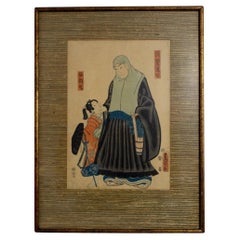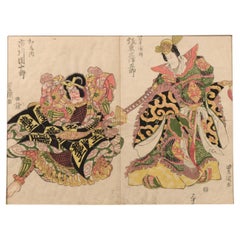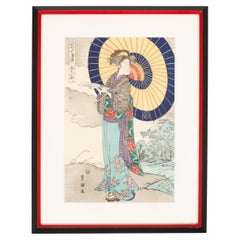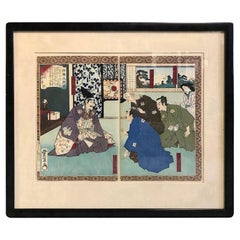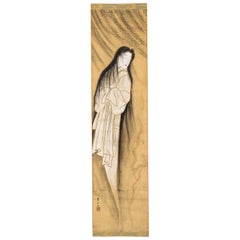Utagawa Toyokuni
Japanese, 1769-1825
Utagawa Toyokuni[a] (歌川 豊国; 1769 – 24 February 1825), also often referred to as Toyokuni I, to distinguish him from the members of his school who took over his gō (art-name) after he died, was a great master of ukiyo-e, known in particular for his kabuki actor prints. He was the second head of the renowned Utagawa school of Japanese woodblock artists, and was the artist who elevated it to the position of great fame and power it occupied for the rest of the nineteenth century.
He was born, the son of Kurahashi Gorobei, a carver of dolls and puppets, including replicas of kabuki actors.
At around 14, Toyokuni was apprenticed to the first head of the Utagawa house, Utagawa Toyoharu, whom his father knew well and who lived nearby.
One of his fellow pupils under Toyoharu was Toyohiro, whose pupil was the great landscape artist Hiroshige. In recognition of his artistic ability, Toyokuni later took the name Utagawa Toyokuni, following the common practice of using one syllable of his master's name.
Toyokuni seems not to have been an "intuitive genius"determined to forge a new path; rather, he seems to have studied intently those who came before him, particularly Utamaro, Chōbunsai Eishi and Eishōsai Chōki and through a great deal of hard work produced first a mastery, and then a synthesis of their styles, to create a style of his own.
He was known mostly for his prints related to the kabuki theatre, in particular his yakusha-e actor portraits, a field which he took to new heights. He also, however, produced other genres such as musha-e warrior prints, shunga erotica, and most notably bijin-ga.
In his actor prints, like Sharaku, one sees the real subject; but his prints merely portrayed what he saw, unlike Sharaku who exaggerated those aspects he saw as the most key. It is said of Toyokuni's prints that they recreate exactly what one would see on stage; they show actors acting, not merely just pictures of actors.
Together, these characteristics made Toyokuni's prints far more popular among theatre-goers than Sharaku's, although history has come to judge Sharaku the keener observer and greater artist.
His popularity and prolific output may in part have been his undoing, though. From 1803 through 1817, his work became more static, even as it became more popular. He continued to produce large quantities of prints, but the quality as a rule did not match that of his earlier days. Occasional prints from this period, however, show his old brillianceto
1
1
2
2
2
2
2
2
2
2
2
12
10,707
3,927
2,502
2,241
Creator: Utagawa Toyokuni
Antique Japanese Woodblock Print by Utagawa Toyokuni III, 三代歌川豊国
By Utagawa Toyokuni
Located in Norton, MA
Unusual Japanese Woodblock Print by Utagawa Toyokuni I (1769~1852), depicting a man in his traditional dress and his right hand holding a young girl, origin...
Category
Mid-19th Century Japanese Antique Utagawa Toyokuni
Materials
Paper
Antique Japanese Woodblock by Utagawa Toyokuni l, 1816
By Utagawa Toyokuni
Located in Amsterdam, Noord Holland
Antique Japanese Woodblock – Utagawa Toyokuni l – 1816 (Honjo, Edo Period 1786-1865 Edo),
Diptych,
Actors Bandô Mitsugorô (R) and Ichikawa Danjûrô (L)
Date: Japanese, Edo period
Pro...
Category
19th Century Japanese Edo Antique Utagawa Toyokuni
Materials
Paper
Related Items
Japanese Woodcut Print Utagawa Kunisada 'Toyokuni III', Kyoto, Japan C.1950
By Utagawa Kunisada (Toyokuni III)
Located in London, GB
A framed woodcut print of a Japanese Lady originally by Utagawa Kunisada (Toyokuni III).
one of the most famous Japanese Ukiyo-e artists, Utagawa Kunisad...
Category
Mid-20th Century Japanese Showa Utagawa Toyokuni
Materials
Paper
$659
H 15.75 in W 12.21 in D 0.99 in
Utagawa Toyonobu Shinsen Taikoki Japanese Woodblock Diptych Print, 19th Century
By Toyonobu Utagawa
Located in Studio City, CA
A Classic image by renowned Japanese printmaker Utagawa Toyonobu from his newly selected history of Toyotomi Hideyoshi series.
A very good impres...
Category
Late 19th Century Japanese Meiji Antique Utagawa Toyokuni
Materials
Paper
$495
H 21.5 in W 26 in D 1 in
19th Century Japanese Scroll Painting by Igarashi Chikusa, Poppies & Butterflies
Located in Kyoto, JP
Poppies & Butterflies
Ink, pigment and gofun on silk
Igarashi Chikusa (1774-1844)
Signature: Chikusa Ran Zen
Upper Seal: Ran Shuzen
Lower Seal: Kyoho
Dimensions:
Scroll: H. 68” x W. 18” (172cm x 45cm)
Image: H. 38.5’’ x W. 12.5’’ (98cm x 32cm)
This composition shows elegant images of poppies and the butterflies that are inevitably drawn to them. It captures a momentary glimpse into a world both visually dazzling and startlingly realistic. The painting is infused with sensitivity and attention to seasonal change and weather conditions. The thin and fragile poppies are beautifully depicted with brilliant colors and the butterflies are similarly infused with life. The painting is on silk which requires extremely precise painting skills as no element once painted can be removed.
Poppies were a favorite subject of Rinpa school artists through the ages. Originally they were somewhat abstracted but by the age of Sakai Hoitsu...
Category
Early 19th Century Japanese Edo Antique Utagawa Toyokuni
Materials
Silk
$4,800
H 68 in W 18 in D 1 in
Early 19th Century Japanese Screen. Cherry Blossom & Pheasants by Mori Tetsuzan
Located in Kyoto, JP
Mori Tetsuzan (1775-1841)
Pheasants and Cherry Blossoms
Two-fold Japanese screen. Ink, color, gofun, gold and silver on paper.
A two-fold Japanese bir...
Category
Early 19th Century Japanese Edo Antique Utagawa Toyokuni
Materials
Gold Leaf
$29,500
H 69 in W 75 in D 0.75 in
Japanese Edo 19th Century Signed Utagawa Kuniyoshi Diptych Woodblock Print
Located in Yonkers, NY
An antique Japanese Edo period diptych woodblock print from the early to mid 19th century, signed by Utagawa Kuniyoshi. Immerse yourself in the Japanese Edo period artistry with this antique 19th-century diptych woodblock print. Signed by the artist, this captivating piece is a striking depiction of a tranquil interior scene, rendered in a soothing color palette of blue, pink, and black tones.
This print comprises two panels, assembled under glass in a custom frame to form a cohesive narrative. The scene captures a specific moment in time, presenting a man surrounded by four women and a child, beautifully adorned in traditional Japanese garments. The intricate details of their clothing are a testament to the artisan's skill, bringing an element of authenticity and depth to the scene.
On the left, three women sit in a state of relaxed conversation, while another stands, graciously offering a tray. Adding intrigue, two additional women can be spotted peeking through a slightly open window, one cleverly concealing her face behind a fan. A child, smaller in stature, sits attentively in front of the man, further enhancing the scene's narrative quality.
A signature from the artist adds an additional layer of authenticity, making this piece a must-have for collectors of antique Japanese art...
Category
19th Century Japanese Edo Antique Utagawa Toyokuni
Materials
Glass, Paint, Paper
$1,900
H 20.5 in W 26 in D 1 in
Utagawa Ando Hiroshige Japanese Woodblock Print Kinryuzan Temple, Asakusa
By Utagawa Hiroshige (Ando Hiroshige)
Located in Studio City, CA
A wonderful Japanese woodblock print by famed Japanese artist Utagawa Hiroshige (Ando Hiroshige) (1797-1858) titled "Kinryuzan Temple, Asakusa" was initially conceived in 1856. It i...
Category
20th Century Japanese Edo Utagawa Toyokuni
Materials
Paper
$695
H 14.5 in W 9.5 in D 0.1 in
Japanese Screen Painting, Circa 1700 'Tales of Ise' by Tosa Mitsusuke
By Tosa Mitsusuke 1
Located in Kyoto, JP
A six-fold Japanese screen by Tosa Mitsusuke (1675-1710), Japan 17th-18th century, Edo period.
The signature reads Shoroku-i ge Tosa sa Konoe Shogen Mit...
Category
Late 17th Century Japanese Edo Antique Utagawa Toyokuni
Materials
Gold Leaf
Sadanobu Hasegawa III Japanese Woodblock Print Kagamijishi (Lion Dance)
Located in Studio City, CA
A beautifully composed and boldly colored Japanese woodblock print by Sadanobu III Hasegawa (1881-1963) titled ''Kagamijishi'' (Lion Dance) featu...
Category
20th Century Japanese Showa Utagawa Toyokuni
Materials
Paper
$595
H 19 in W 13.75 in D 0.15 in
17th Century Japanese Screen Pair. Tiger & Dragon by Kaiho Yusetsu
Located in Kyoto, JP
Kaiho Yusetsu (1598-1677)
Tiger and Dragon
Early Edo Period, Circa 1650
A Pair of Six-fold Japanese Screens. Ink and slight color on paper.
Dimensions:
Each screen: H. 171 cm x W. 380 cm (67.5’’ x 149.5’’)
In this pair of early Edo period Japanese screens a group of tigers prowl in a bamboo grove whipped with fierce wind, while a dragon claws through clouds and mist. The dragon embodies elemental qualities - looming out of the mist, the coils of its body disappearing in the clouds. The dragon is calling for rain, symbolizing spring which is considered the fountain of life. On the other side, the tigers calls for the wind, symbolizing autumn which is considered the end of life. Tigers were familiar motifs within Japanese art from ancient times though the animals were imaginary to the people in the 17th century. While dragons and tigers are usually associated as sacred and ferocious, in this painting, both animals have rather amusing expressions. The tigers appear to glare at the dragon with cat-like eyes, and the look on the swirling dragon’s face appears almost affectionate - lending a playful flair to an otherwise magnificent theme.
The tiger and dragon are cosmological symbols of the balancing forces in the world. Screens such as this were originally meant to express the fluctuating nature of the world. For Japanese in the early Edo period, they likely suggested the powers of the cosmos. In Japan the tiger and dragon motif was originally absorbed into the circles of Zen monasteries before spreading into the secular world. The theme especially appealed to the military classes with the Kano school, the official painters to the Shogun and the samurai, being the leading contributors. The painter of this pair of screens, Kaiho Yusetsu (1598-1677), was closely patronized by the third Shogun Tokugawa Iemitsu. In his later years he worked with Kano school artists...
Category
Mid-17th Century Japanese Edo Antique Utagawa Toyokuni
Materials
Silk, Wood, Paper
$78,000 / set
H 67.5 in W 149.5 in D 0.75 in
19th Century Japanese Silk Painting by Kano Chikanobu, Phoenix & Paulownia
Located in Kyoto, JP
Birds & Flowers of the seasons
Pheasants & Plum in Snow
Unframed painting. Ink, pigment and gofun on silk
Kano Chikanobu 1819-1888
Signature...
Category
Mid-19th Century Asian Edo Antique Utagawa Toyokuni
Materials
Silk
$4,500
H 46 in W 19.5 in D 0.01 in
Utagawa Kunisada Japanese Woodblock Print
By Utagawa Kunisada (Toyokuni III)
Located in Miami, FL
A fine, professionally framed original Japanese woodblock print attributed to the master Utagawa Kunisada (1786 – 1865), also known as Utagaw...
Category
19th Century Japanese Edo Antique Utagawa Toyokuni
Materials
Wood, Paper
Japanese Screen Pair, Tigers by Kishi Renzan, Late Edo Period
Located in Kyoto, JP
Kishi Renzan (1804-1859)
Tigers
Pair of six-panel Japanese screens.
Ink and gold-leaf on paper.
In this monochromatic pair of six-fold Japanese screens painted on gold-leaf, Kishi Renzan has created a breathtaking composition of a family of tigers. The screens are filled with a sense of drama which is conveyed by both the subject matter and the wet, expressive brushwork. The running mountain stream and the towering waterfall allude to refreshment during the summer months and we feel the tiger families familiarity and security within their environment. Renzan’s master, Kishi Ganku...
Category
Mid-19th Century Asian Edo Antique Utagawa Toyokuni
Materials
Gold Leaf
$38,000 / set
H 67.5 in W 148 in D 0.75 in
Previously Available Items
Japanese Scroll of the Spirit of a Beautiful Woman, Seal Reads Toyokuni
By Utagawa Toyokuni
Located in Hudson, NY
Japanese Scroll of the Spirit of a Beautiful Woman. Late Edo period (circa 1800) painting of a spirit of a beautiful woman with long, flowing hair. Signature and seal reads Toyokuni ...
Category
Early 19th Century Japanese Edo Antique Utagawa Toyokuni
Materials
Silk, Wood, Paper
Utagawa Toyokuni furniture for sale on 1stDibs.
Utagawa Toyokuni furniture are available for sale on 1stDibs. These distinctive items are frequently made of paper and are designed with extraordinary care. There are many options to choose from in our collection of Utagawa Toyokuni furniture, although gray editions of this piece are particularly popular. If you’re looking for additional options, many customers also consider furniture by Kutani Studio, and Makuzu Kozan. Prices for Utagawa Toyokuni furniture can differ depending upon size, time period and other attributes — on 1stDibs, these items begin at $1,645 and can go as high as $1,882, while a piece like these, on average, fetch $1,763.
